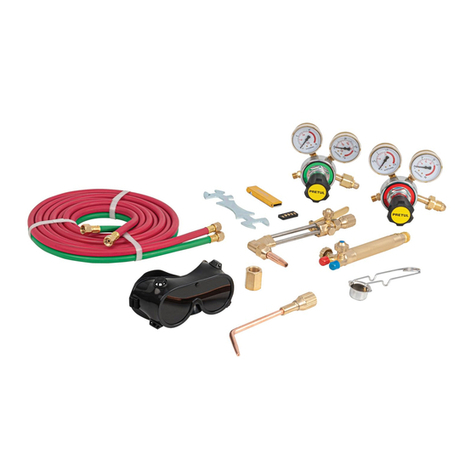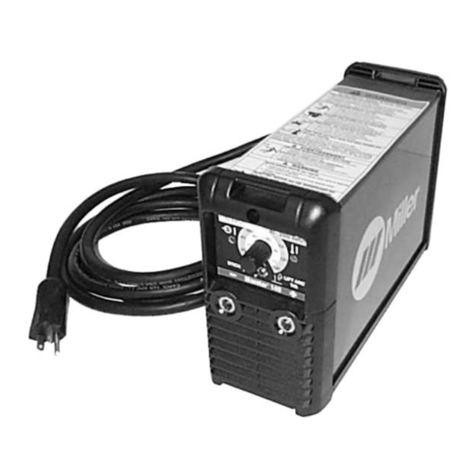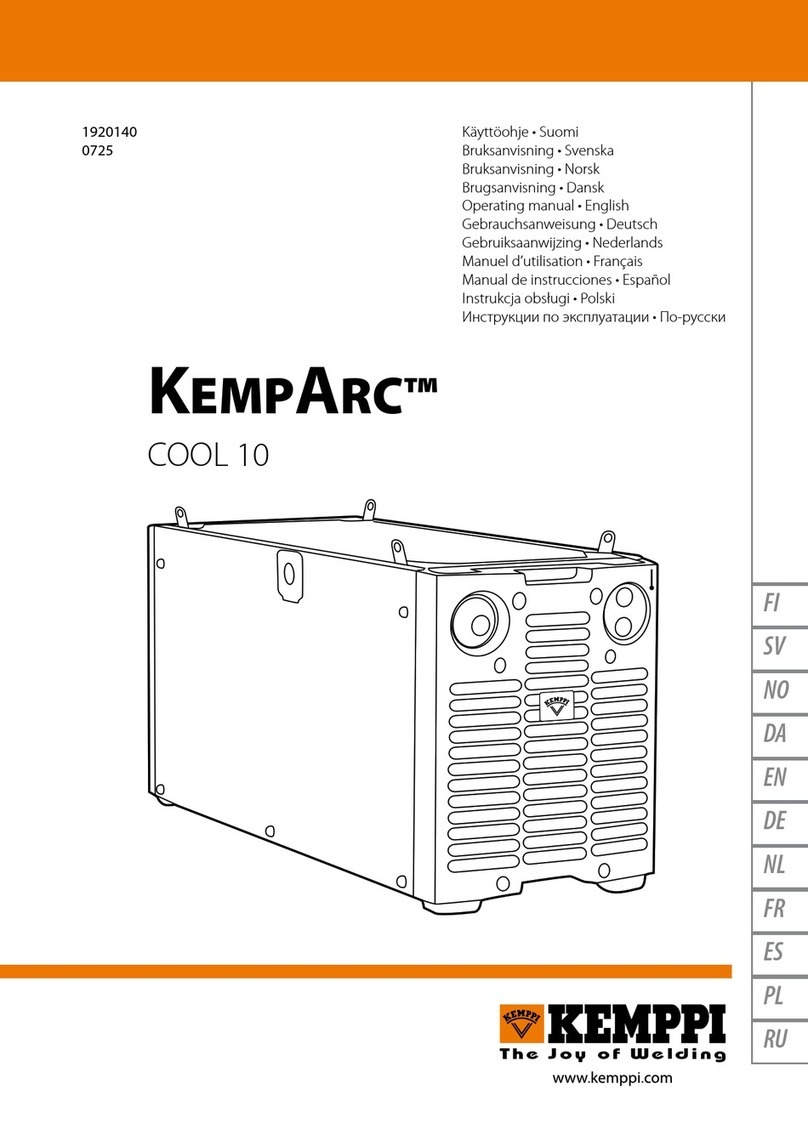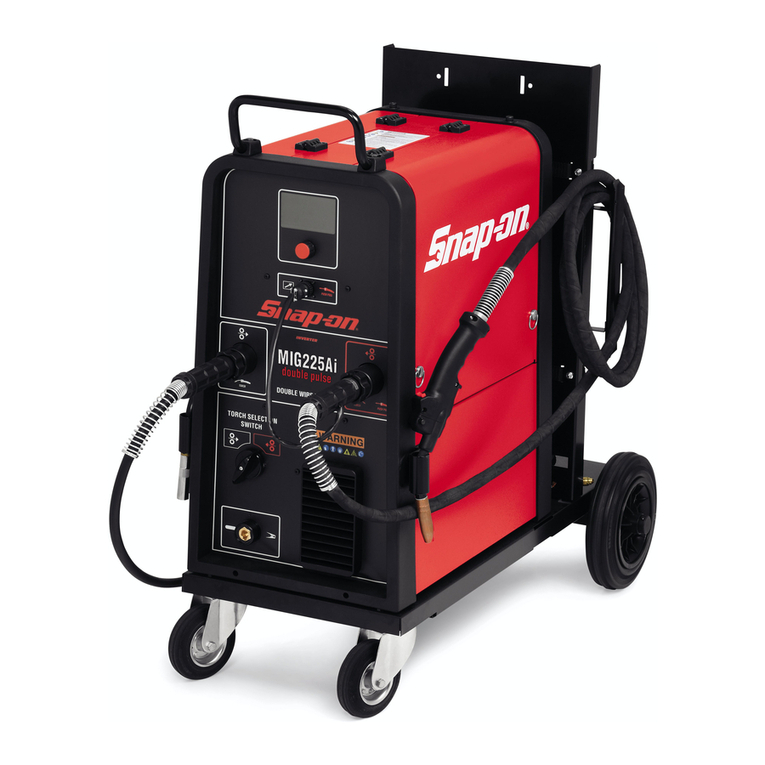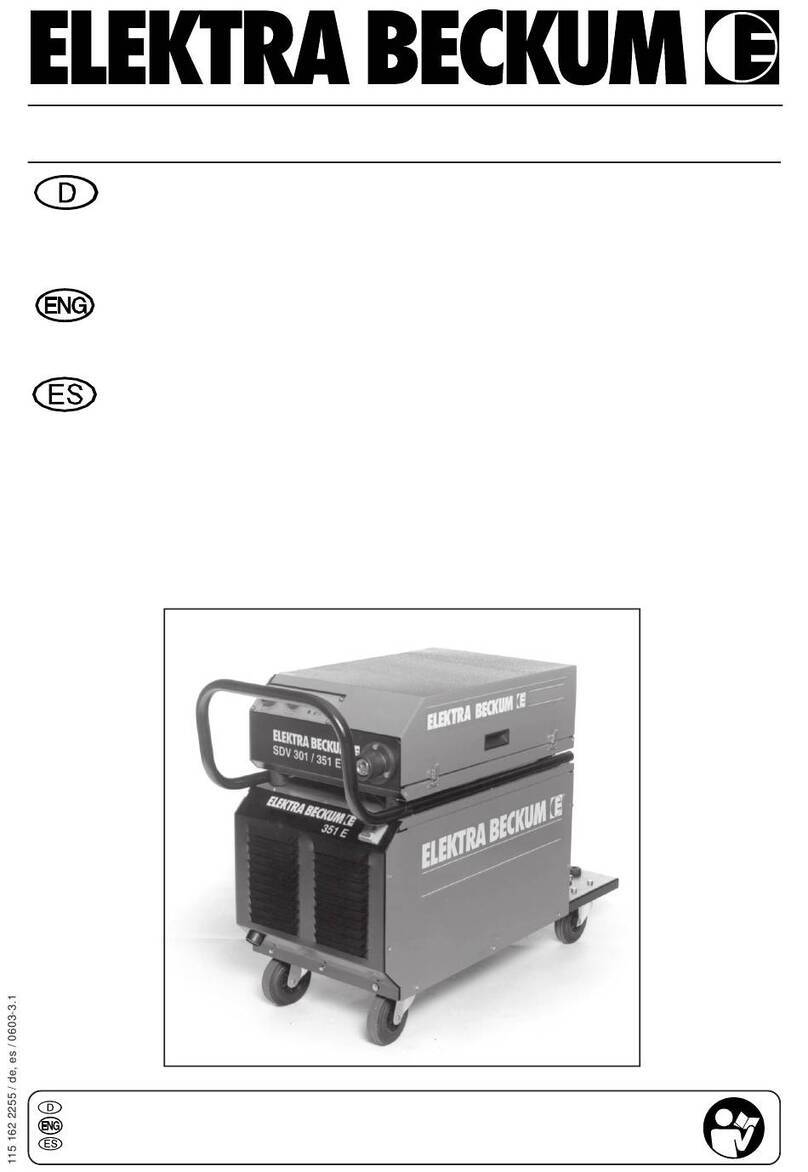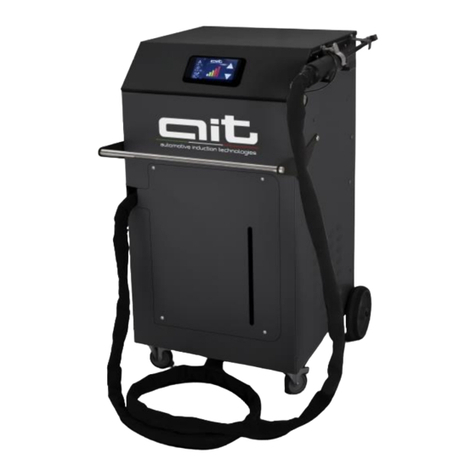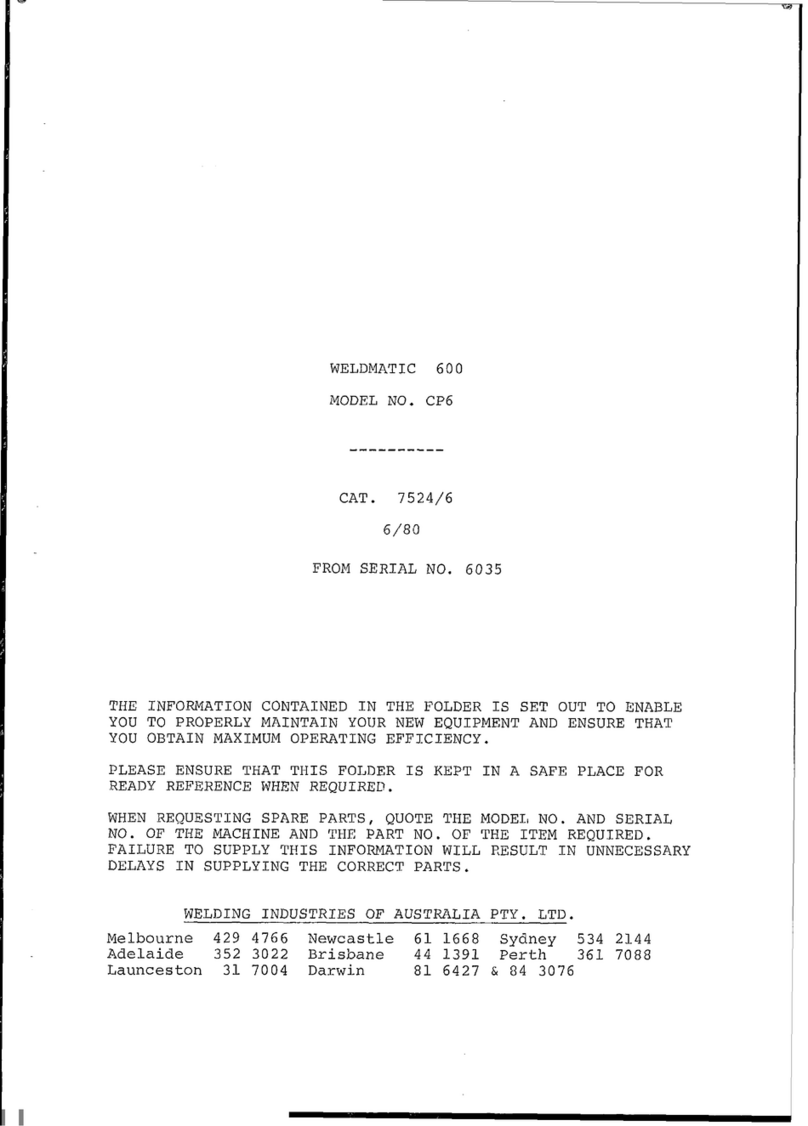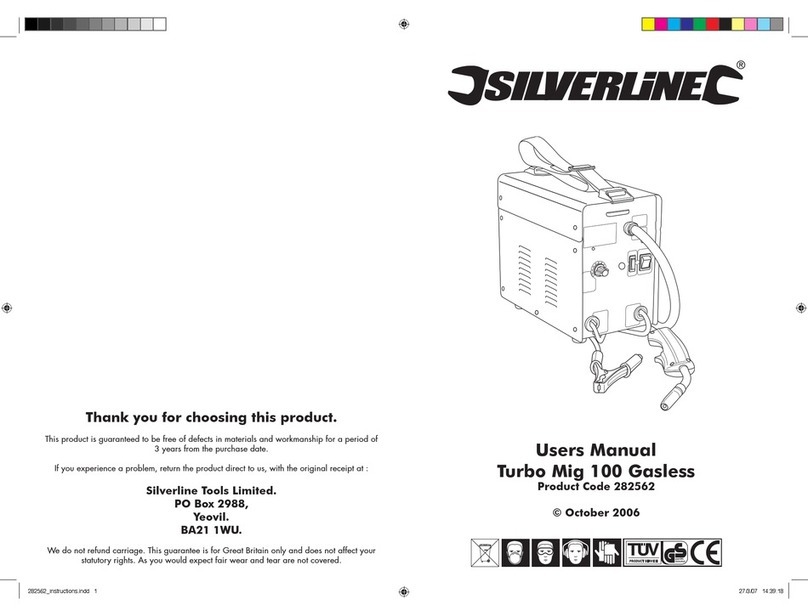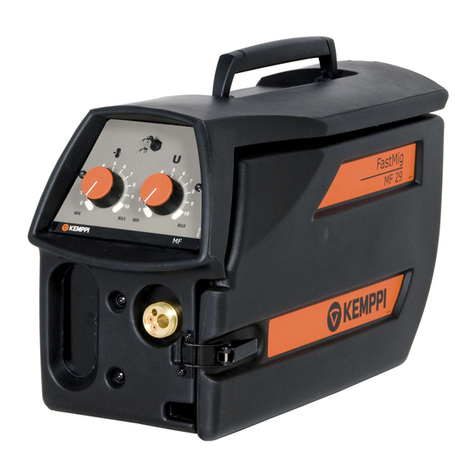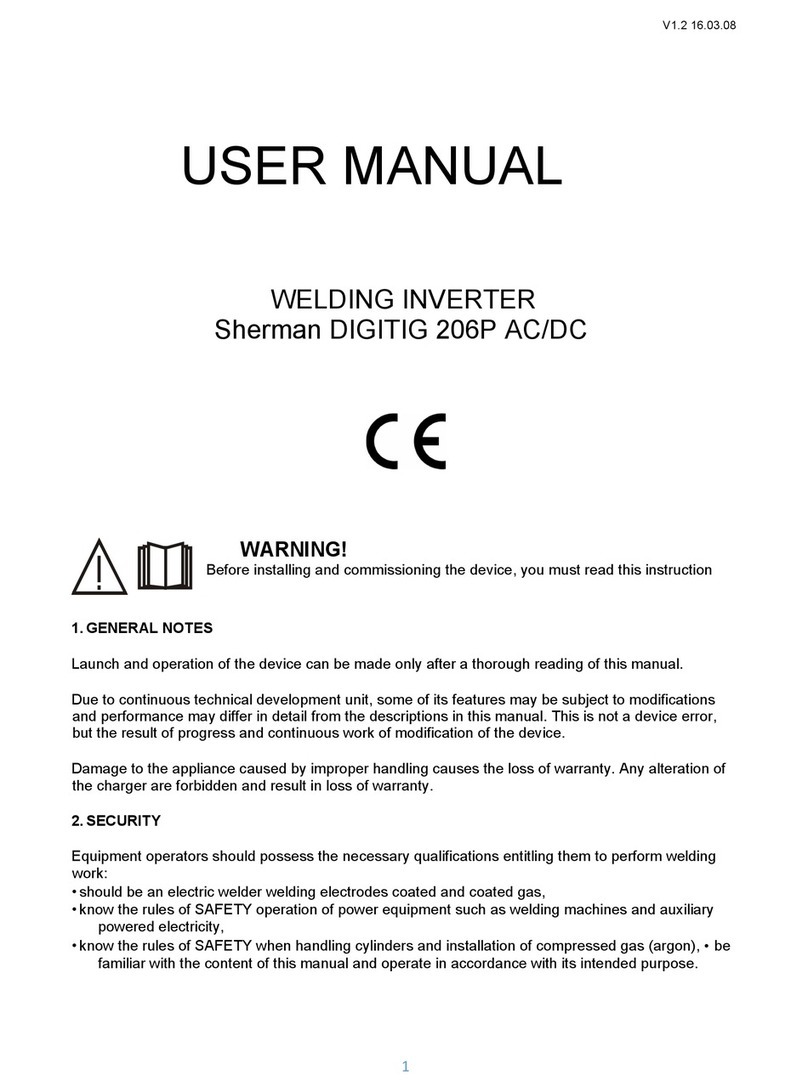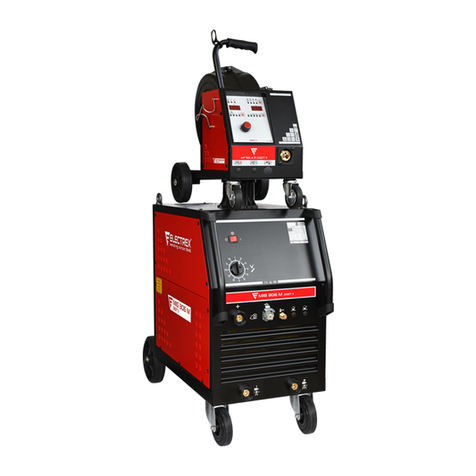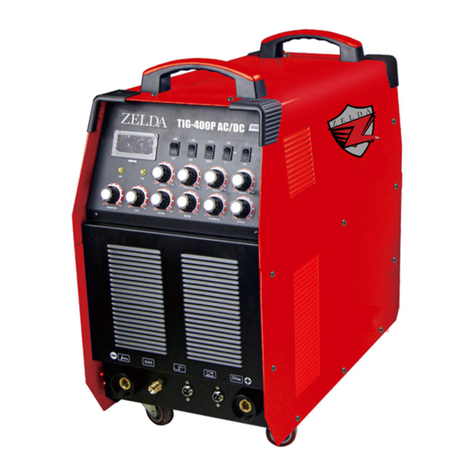PRETUL SOIN-101MP User manual

ALARMA
Manual
Inverter
Welder
ModelCode
SOIN-101MP
Applies for:
29961
CAUTION Read this manual thoroughly
before using the tool.
INGLÉS
ESPAÑOL
60%
Work Cycle

ALARMA
2
SOIN-101MP
ENGLISH
Contents
CAUTION
Keep this manual for future references.
The illustrations in this manual are for reference
only. They might be different from the real tool.
To gain the best performance of
the tool, prolong the duty life,
make the Warranty valid if
necessary, and to avoid hazards
of fatal injuries please read and
understand this Manual before
using the tool.
Technical specifications
Power Requirements
General Power Tools Safety Warnings
Safety Warnings for Inverter Welders
Parts
Installation (SMAW)
Start Up
Maintenance
Troubleshooting
Authorized Service Centers
Warranty Policy
3
3
4
5
6
7
8
10
10
11
12

3
Technical specifications
ENGLISH
Power cord grips: Type “Y”.
Build quality: Basic insulation.
Thermal insulation winding: Class H
Power Requirements
29961
Code
Description
SOIN-101MP
Rated Input Capacity
Input Voltage
Current Range 20 A - 100 A
Power Factor Cos 0.73
Inverter Welder
127 V / 60 Hz
1/16” - 1/8”
3.8 kVA
Electrode
IP21S
IP Grade
8.34” x 3.4” x 5.3”
Dimension
60%
6 minutes’ work per 4 minutes’ rest.
Output values specified are with a 68 ºF Temperatures higher than the work cycle may be reduced.
Rated Duty Cycle
Insulation Class I
12 AWG x 2C with 221 °F insulation temperature
Conductors
5 lb
Weight
Open Circuit Voltage 69 V c.c.
WARNING
WARNING Avoid the risk of electric shock or severe injury. When the power cable gets damaged
it should only be replaced by the manufacturer or at a Authorized Service Center.
The build quality of the electric insulation is altered if spills or liquid gets into the tool while in use.
Do not expose to rain, liquids and/or dampness.
Before gaining access to the terminals all power sources should be disconnected.
If faults or breakdowns happen. Ground connection offers a
trajectory with minimum resistance for electric power. It reduces the risk of electric
shock. This tool is built with a power cable with an earth conductor and a plug with
ground connection. The plug shall be connected into a power outlet installed and
grounded according to all local codes.
Do not modify the plug supplied. If the plug cannot be fitted
to the socket, have a qualified electrician to install the suitable socket.
• When using the welder together with more tools using the same ground connect those in parallel, never connect a
series.
• The gauge of the ground conductor cable shall not be of a smaller gauge than the power supply cable.
• Connection to the power supply shall only be carried out by a professional electrician.
• Double check the input connection voltage stipulated in the welder nameplate matches the power
supply voltage.
• The power supply cord shall meet the following requisites:
CAUTION
CAUTION
CAUTION
* The current for fuse fusion is double of its rated current.
Switch
Fuse (Work Rated Current)
Electric Wire
30 A
30 A (*)
2.5 mm2
• If extensions between the welder and the work piece
are needed, the soldering cable gauge shall be increased
to keep the welder energy output with a potential drop
not higher than 4 V
CAUTION
WARNING
WARNING

4
General Power Tools
Safety Warnings
ENGLISH
Work area
Keep your work area clean, and well lit.
Cluttered and dark areas may cause accidents.
Never use the tool in explosive atmospheres, such as in the
presence of flammable liquids, gases or dust.
Sparks generated by power tools may ignite the flammable material.
Keep children and bystanders at a safe distance while operating
the tool.
Distractions may cause loosing control.
Electrical Safety
The tool plug must match the power outlet. Never modify
the plug in any way. Do not use any adapter plugs with
grounded power tools.
Modified plugs and different power outlets increase the risk of electric shock.
Avoid body contact with grounded surfaces, such as pipes,
radiators, electric ranges and refrigerators.
The risk of electric shock increases if your body is grounded.
Do not expose the tool to rain or wet conditions.
Water entering into the tool increases the risk of electric shock.
Do not force the cord. Never use the cord to carry, lift or unplug
the tool. Keep the cord away from heat, oil, sharp edges or
moving parts.
Damaged or entangled cords increase the risk of electric shock.
When operating a tool outdoors, use an extension cord suitable
for outdoor use.
Using an adequate outdoor extension cord reduces the risk of electric shock.
If operating the tool in a damp location cannot be avoided, use
a ground fault circuit interrupter (GFCI) protected supply.
Using a GFCI reduces the risk of electric shock.
Personal safety
Stay alert, watch what you are doing and use common sense
when operating a tool. Do not use a power tool while you are
tired or under the influence of drugs, alcohol or medication.
A moment of distraction while operating the tool may result in personal injury.
Use personal protective equipment. Always wear eye
protection.
Protective equipment such as safety glasses, anti-dust mask, non-skid shoes,
hard hats and hearing protection used in the right conditions significantly
reduce personal injury.
Prevent unintentional starting up. Ensure the switch is in the
“OFF” position before connecting into the power source and /
or battery as well as when carrying the tool.
Transporting power tools with the finger on the switch or connecting power
tools with the switch in the “ON” position may cause accidents.
Remove any wrench or vice before turning the power tool on.
Wrenches or vices left attached to rotating parts of the tool may result in personal
injury.
Do not overreach. Keep proper footing and balance at all times.
This enables a better control on the tool during unexpected situations.
Dress properly. Do not wear loose clothing or jewelry. Keep
hair, clothes and gloves away from the moving parts.
Loose clothes or long hair may get caught in moving parts.
If you have dust extraction and recollection devices connected
onto the tool, inspect their connections and use them correctly.
Using these devices reduce dust-related risks.
Power Tools Use and Care
Do not force the tool. Use the adequate tool for your
application.
The correct tool delivers a better and safer job at the rate for which it was designed.
Do not use the tool if the switch is not working properly.
Any power tool that cannot be turned ON or OFF is dangerous and should be
repaired before operating.
Disconnect the tool from the power source and / or battery
before making any adjustments, changing accessories or
storing.
These measures reduce the risk of accidentally starting the tool.
Store tools out of the reach of children. Do not allow persons
that are not familiar with the tool or its instructions to
operate the tool.
Power tools are dangerous in the hands of untrained users.
Service the tool. Check the mobile parts are not misaligned or
stuck. There should not be broken parts or other conditions that
may affect its operation. Repair any damage before using the
tool.
Most accidents are caused due to poor maintenance to the tools.
Keep the cutting accessories sharp and clean.
Cutting accessories in good working conditions are less likely to bind and are
easier to control.
Use the tool, components and accessories in accordance with
these instructions and the projected way to use it for the type of
tool when in adequate working conditions.
Using the tool for applications different from those it was designed for, could
result in a hazardous situation.
Service
Repair the tool in a Authorized Service Center
using only identical spare parts.
This will ensure that the safety of the power tool is maintained.
Children or people with reduced physical, sensory or mental
capabilities shall not operate the tool, neither inexperienced
people or without knowledge in the use of the tool, unless
supervised by a person responsible of their safety or if receiving
previous instructions about the tool operation.
Children shall be kept under supervision to double-check they will not play
with the tool. Tight supervision shall be used with children or disabled
persons to prevent from using or being close to any household tool.
WARNING! Read carefully all safety warnings and instructions listed below. Failure to comply with any of
these warnings may result in electric shock, fire and / or severe damage. Save all warnings and instructions for
future references.
This tool is in compliance with
the Official Mexican Standard
(NOM - Norma Oficial Mexicana).

5
Safety Warnings for
Inverter Welders
ENGLISHENGLISH
• Wear a welding mask to protect eyes
and face when soldering. Assure the mask protective glass
shade is adequate for the soldering process to carry out.
• Wear leather gloves specially made for
welding as well as leather dungarees and gaiter.
• Wear robust clothing and long sleeves made of fire-resistant
materials such as wool or leather.
• Use special screens or curtains to insulate the work place from
passersby, to protect them from sparks, flares and slag originated by
the soldering process.
• Benches and work tables where work pieces shall rest, must have
orifices or slots that can easily let through residues originated by the
soldering process.
• Vapor and gases produced while soldering is
dangerous to your health. Work in well ventilated areas or with
adequate ventilation systems.
• Do not breath in smokes and gasses
emanated from the soldering process. Keep your head away
from vapors.
• If ventilation is poor use an adequate
autonomous breathing device because the gases generated
when soldering may displace air and cause a fatal accident.
• Do not operate the welder near de-greasing
agents, cleaning products or aerosol containers. Heat and
radiation from the welding process may react to those vapors
forming toxic gases.
• Avoid soldering metals covered in lead, zinc or
cadmium. Those materials generate toxic gases. Otherwise,
remove the covering from the welding area. Make sure the work
area is well ventilated or wear an adequate autonomous
breathing device.
Protection Equipment for Welding
CAUTION
CAUTION
CAUTION
WARNING
DANGER
• Verify there is a safe connection for the input and
output cables. They shall be correctly insulated and the connections in
good repair (check and eliminate any possibility of electric shock).
• Double check the welder is plugged to a
reliable ground connection.
• Do not expose the welder to rain or humidity.
• The user shall be insulated from the work piece and
ground connection stepping onto insulating and dry mats.
• For any reason touch the two poles in the welder
circuit (welding stick and work piece).
• Do not try to adjust the welder current when
carrying out a soldering job.
• Connect the ground clamp to the work piece as
close as possible to the welding zone. This prevents the current to flow
long distances and eliminate the possibility of short circuit.
• The work piece shall make contact with the ground
connection clamp before operating the welder. Do not disconnect
until finishing welding because it can lead to an electric discharge and
severe injury.
• Disconnect the welder from the power supply
before carrying any maintenance jobs.
Prevent Electric Shock
• Have always handy a fire extinguisher in
good conditions.
• There shall not be flammable or explosive
materials in the work area (no less than 36’). Do not carry out
soldering jobs where the sparks can reach or fall onto
flammable or explosive materials.
Fire Prevention
CAUTION
CAUTION
CAUTION
CAUTION
CAUTION
CAUTION
DANGER
WARNING
WARNING
WARNING
WARNING
Prevent Health Risks
WARNING
WARNING
• Risks of electric shock:
An electric shock coming from the soldering electrode may
cause death. Do not weld under rain or snow. Do not touch the
electrode with your bare hands. Do not wear damp or damaged
gloves. Personal protection against electric shock: insulation from the
work piece. Do not open the equipment enclosure. Do not weld on
top of drums or any closed container.
• Soldering sparks may cause explosion
or fire.
• Risks generated by the welding arc:
Radiation coming out from the arc my burn eyes and damage skin.
Wear face mask and protection glasses. Wear hearing
protection and protective clothes that protect skin up to
the neck. Wear full-body protective clothes.
• Risk induced by electro-magnetic fields:
Welding current produces electro-magnetic fields. Do not
use this power source if having a medical implant. Never roll up the
welding cable around your body. Set together and parallel both
welding cables so the fields of each cable counteract.
• Do not use the welder power source to de-ice pipes.
• Never allow unexperienced people to dismount or
regulate the welder.
• Double check that the operator and the welder
are away from the sparks and residues trajectory originated by the
soldering process.
• The welder shall be operated in a place protected from sun and
rain. Away from places where violent vibrations are present.
• Store the welder in a place free of humidity with a range of
temperature from -13 °F to +131 °F
• There shall be a 11.8” space around the welding machine to allow
good ventilation.
• Double check no foreign metal piece is inside the
welder.
• Any problem with the welder that cannot be fixed
by the operator making the adjustments needed for a good welding
job shall be carry out in a Authorized Service
Center. For any reason try to open the welder housing to carry out
any type of maintenance.
Prevent Injuries and Accidents
CAUTION
CAUTION
WARNING
WARNING
WARNING
WARNING
WARNING
WARNING
WARNING

ALARMA
Power
Adjustment
Control
Positive
Connection
( + )
Negative
Connection
(
-
)
Work Piece
Grounding Clamp
Ventilation
Slots
Power
Cord
Strap
Slots
Ventilation
Inlet
Hammer-Brush
for Slag Removal
Carrying
Strap
Protective
Mask
Switch
Electrode
Holder
6
Parts
ENGLISH
To get better results use a Brand
cable set with soldering clamp CAB-200

ALARMA
D
7
C
ENGLISH
Set the adequate
electrode for the job
into the electrode holder
Metal
work
bench
Connections
To prevent electric shock please consult
information in the “Electrical Requirements” section in
pages 3 and 5.
• The fast connections in the electrode holder and the
grounding clamp are inserted and turned one quarter of a
turn in a clockwise direction in the outlets found iin the
front panel to be secured.
Inverse Polarity (A)
• Connect the grounding clamp cable to the negative (
-
)
clamping screw in the welder.
• Connect grounding clamp cable (C) to the work piece.
• Connect the electrode holder cable to the positive
(+)
clamping screw in the welder.
This configuration generates more heat in the electrode,
thus producing more penetration with basic electrodes
making it ideal to weld thick pieces.
Direct Polarity (B)
• Connect the grounding clamp cable to the outlet (+).
• Connect the grounding clamp (C) to the work piece.
• Connect the electrode holder to the outlet
(
-
)
.
This configuration generates more heat in the work piece
producing less warping of the piece and narrower cords
making it ideal to solder thin pieces.
• Connect the feeding cable (D) to the network into the
corresponding voltage (127 V~).
Before using the welder, it shall be
correctly grounded. Failure to comply with this warning
propitiates severe personal injuries.
CAUTION
WARNING
A
B
Inverse Polarity
Direct Polarity
C
C
Installation (SMAW)

ALARMA
8
B C
D
ENGLISH
Preparation
• Only experience, practice and care can guarantee a good
welding job.
• The factor intervening in the welding process are many:
required current, distance between the electrode and the
work piece, soldering speed and direction, thickness and
type of the material, the work piece position, electrode
angle and also gauge, type of material and electrode
covering. Therefore, is advisable that before welding to
carry out practice some in scrap material to determine
which are the specific requirements needed for the job to
perform.
• The area on the work piece where the soldering will be
applied shall be clean, free of rust and paint.
• Joints between sheets with gauges higher than 1/8” shall
be beveled to have an adequate weld (A).
Welding
• Set the switch (B) into the ON position.
• Adjust current control knob (C) until proper arc current
and intensity are achieved for the job. The current is
indicated on the panel display (D).
• Hold the electrode holder or torch as comfortable as
possible. Bear in mind that during the welding process, the
angle, movement and distance regarding the work piece
shall be constant and uniform.
• Aim the electrode tip to the joint to be worked with to
generate the arc and start welding.
• Once the arc is lit start soldering keeping always the
electrode tip 0.08” away from the work piece. If you make
the weld having the electrode supported on the work
piece, it could adhere and the weld would have a low
quality.
Electrode Replacement
• When the electrode has been consumed 0.4” to 0.8”
away from the electrode holder, it is necessary to replace it
with a new one to keep on welding.
• Electrodes are burned in high
temperature. Do not try to manipulate the remains of the
electrode with your hand. Set the remains in a metal
container.
• Open the electrode holder nipper to hold the new
electrode by the end that is not covered. Do not hold the
electrode by the covered part.
CAUTION
Slag Removal
• Upon finishing welding, use the wire brush included to
remove the slag from the weld bead surface.
• Wait until the slag has cooled down
and hardened to remove it.
• When hitting or brushing slag to remove it there can
be particles flying out. Wear eye protection and
keep bystanders away.
CAUTION
A
45° 45°
45°60°
60°
60°
Start Up

9
ENGLISH
Examples of welding
Correctly
Applied Welding
Electrode
Electrode movement
too fast and / or
very low current.
Thin Sheets
Thick Sheets
Electrode movement
too slow and / or
very high current.
Spiral
movement.
Half-Moon
movement.
Zigzag
Movement.
Spot Weld.
Overlapped
Joint.
Angle welding
of thick sheets.
Angle welding of thin
sheets to thick sheets.
Electrode too
separated from
the work piece.
Bevel
Start Up

Maintenance
10 ENGLISH
The thermal protection
light is ON.
The current adjusting
control is not working.
The fan is not working
or turns very slowly.
There is no open
circuit voltage.
The electrode holder is
too hot; connections +
and - are hot.
Energy source is off.
Big splash.
• The welder has no adequate ventilation.
• Environment temperature is too high.
• The welder has been used longer than the
recommended work cycle.
• The potentiometer is broken.
• Faulty switch.
• Faulty fan.
• Fault in the connections.
• High Voltage, low voltage or one phase is
missing.
• The welder is overheating.
• Faulty switch.
• The electrode capacity is too low.
• The cable gauge is too small.
• Loose connections.
• More resistance between the
electrode holder and the cable.
• The welder is hover-heated.
• The connection of Output is wrong.
Problem Cause Solution
If after all the recommended actions have been carried out the problems persist,
contact a Authorized Service Center.
• The correct use and regular cleansing extend the useful life of the welder.
• Only qualified personnel shall carry out repairs. We recommend visiting a
Authorized Service Center to repair your welder, get supplies or accessories.
CAUTION
Regular Maintenance
• Clean dust from the welder with compressed air. If there
is too much dust present, clean immediately. Under
normal conditions clean once a year. If the welder is
exposed to a lot of dust, cleaning should be carried out
every three months.
• Altogether with cleaning make a checkup to assure there
are no loose parts or components in the welder.
• Keep the welder plug in good repair.
• The plug shall be checked before each use.
Storage
• In the event the welder will be stored a long period of
time, keep it in a dry, well ventilated place to prevent
humidity getting inside, or to generate rust or toxic gas.
Storage temperature vary between -13 °F to 131 °F and
relative humidity shall not be over 90%.
• Keep the welder least 11.8” away from any walls at to
allow air circulation.
• The welder will recuperate once the temperature gets
back to the right range to operate.
• The welder will recuperate once the temperature gets
back to the right range to operate.
• Go to a Authorized Service Center
to replace the potentiometer.
• Go to a Authorized Service Center
to replace the switch.
• Go to a Authorized Service Center
to repair the fan.
• Check all the connections.
• The welder will recuperate once the temperature is
back into the adequate range to operate.
• Go to a Authorized Service Center
to replace the switch.
• Replace the electrode holder with another one with more capacity.
• Replace the cable with another one within the requirements
(see page 3).
• Clean the rust accumulation and tighten the connections.
• Clean the rust accumulation and tighten the connections.
• There is no fault. It is normal that power supply gets cut when
the welder goes above its normal working temperature. Wait
until the temperature is back to the adequate working range to
turn it on again.
• Exchange the Output line.
Troubleshooting

11
ENGLISH
Authorized Service Centers
In the event of any problem contacting a Truper Authorized Service Center, please see our webpage www.truper.com
to get an updated list, or call our toll-free numbers 800 690-6990 or 800 0187-8737 to get information about the
nearest Service Center.
AGUASCALIENTES
BAJA
CALIFORNIA
BAJA
CALIFORNIA SUR
CAMPECHE
CHIAPAS
CHIHUAHUA
MEXICO CITY
COAHUILA
COLIMA
DURANGO
ESTADO DE
MÉXICO
GUANAJUATO
GUERRERO
HIDALGO
JALISCO
MICHOACÁN
MORELOS
NAYARIT
NUEVO LEÓN
OAXACA
PUEBLA
QUERÉTARO
QUINTANA ROO
SAN LUIS
POTOSÍ
SINALOA
SONORA
TABASCO
TAMAULIPAS
TLAXCALA
VERACRUZ
YUCATÁN
DE TODO PARA LA CONSTRUCCIÓN
GRAL. BARRAGÁN #1201, COL. GREMIAL, C.P. 20030,
AGUASCALIENTES, AGS. TEL.: 449 994 0537
SUCURSAL TIJUANA
AV. LA ENCANTADA, LOTE #5, PARQUE INDUSTRIAL EL
FLORIDO II, C.P 22244, TIJUANA, B.C.
TEL.: 664 969 5100
FIX FERRETERÍAS
FELIPE ÁNGELES ESQ. RUIZ CORTÍNEZ S/N, COL. PUEBLO
NUEVO, C.P. 23670, CD. CONSTITUCIÓN, B.C.S.
TEL.: 613 132 1115
TORNILLERÍA Y FERRETERÍA AAA
AV. ÁLVARO OBREGÓN #324, COL. ESPERANZA
C.P. 24080 CAMPECHE, CAMP. TEL.: 981 815 2808
FIX FERRETERÍAS
AV. CENTRAL SUR #27, COL. CENTRO, C.P. 30700,
TAPACHULA, CHIS. TEL.: 962 118 4083
SUCURSAL CHIHUAHUA
AV. SILVESTRE TERRAZAS #128-11, PARQUE INDUSTRIAL
BAFAR, CARRETERA MÉXICO CUAUHTÉMOC, C.P. 31415,
CHIHUAHUA, CHIH. TEL. 614 434 0052
FIX FERRETERÍAS
EL MONSTRUO DE CORREGIDORA, CORREGIDORA # 22,
COL. CENTRO, C.P. 06060, CUAUHTÉMOC, CDMX.
TEL: 55 5522 5031 / 5522 4861
SUCURSAL TORREÓN
CALLE METAL MECÁNICA #280, PARQUE INDUSTRIAL
ORIENTE, C.P. 27278, TORREÓN, COAH.
TEL.: 871 209 68 23
BOMBAS Y MOTORES BYMTESA DE MANZANILLO
BLVD. MIGUEL DE LA MADRID #190, COL. 16 DE
SEPTIEMBRE, C.P. 28239, MANZANILLO, COL.
TEL.: 314 332 1986 / 332 8013
TORNILLOS ÁGUILA, S.A. DE C.V.
MAZURIO #200, COL. LUIS ECHEVERRÍA, DURANGO,
DGO.TEL.: 618 817 1946 / 618 818 2844
SUCURSAL CENTRO JILOTEPEC
AV. PARQUE INDUSTRIAL #1-A, C.P. 54240, JILOTEPEC,
EDO. DE MÉX. TEL: 761 782 9101 EXT. 5728 Y 5102
CÍA. FERRETERA NUEVO MUNDO S.A. DE C.V.
AV. MÉXICO - JAPÓN #225, CD. INDUSTRIAL, C.P. 38010,
CELAYA, GTO. TEL.: 461 617 7578 / 79 / 80 / 88
CENTRO DE SERVICIO ECLIPSE
CALLE PRINCIPAL MZ.1 LT. 1, COL. SANTA FE, C.P. 39010,
CHILPANCINGO, GRO. TEL.: 747 478 5793
FERREPRECIOS S.A. DE C.V.
LIBERTAD ORIENTE #304 LOCAL 30, INTERIOR DE PASAJE
ROBLEDO, COL. CENTRO, C.P. 43600, TULANCINGO,
HGO. TEL.: 775 753 6615 / 775 753 6616
SUCURSAL GUADALAJARA
AV. ADOLFO B. HORN # 6800, COL: SANTA CRUZ DEL
VALLE, C.P.: 45655, TLAJOMULCO DE ZUÑIGA, JAL.
TEL.: 33 3606 5285 AL 90
FIX FERRETERÍAS
AV. PASEO DE LA REPÚBLICA #3140-A, COL.
EX-HACIENDA DE LA HUERTA, C.P. 58050, MORELIA,
MICH. TEL.: 443 334 6858
FIX FERRETERÍAS
CAPITÁN ANZURES #95, ESQ. JOSÉ PERDIZ, COL.
CENTRO, C.P. 62740, CUAUTLA, MOR.
TEL.: 735 352 8931
HERRAMIENTAS DE TEPIC
MAZATLAN #117, COL. CENTRO, C.P. 63000, TEPIC, NAY.
TEL.: 311 258 0540
SUCURSAL MONTERREY
CARRETERA LAREDO #300, 1B MONTERREY PARKS,
COLONIA PUERTA DE ANÁHUAC, C.P. 66052, ESCOBEDO,
NUEVO LEÓN, TEL.: 81 8352 8791 / 81 8352 8790
FIX FERRETERÍAS
AV. 20 DE NOVIEMBRE #910, COL. CENTRO, C.P. 68300,
TUXTEPEC, OAX. TEL.: 287 106 3092
SUCURSAL PUEBLA
AV PERIFÉRICO #2-A, SAN LORENZO ALMECATLA,
C.P. 72710, CUAUTLACINGO, PUE.
TEL.: 222 282 8282 / 84 / 85 / 86
ARU HERRAMIENTAS S.A DE C.V.
AV. PUERTO DE VERACRUZ #110, COL. RANCHO DE
ENMEDIO, C.P. 76842, SAN JUAN DEL RÍO, QRO.
TEL.: 427 268 4544
FIX FERRETERÍAS
CARRETERA FEDERAL MZ. 46 LT. 3 LOCAL 2, COL EJIDAL,
C.P. 77710 PLAYA DEL CARMEN, Q.R.
TEL.: 984 267 3140
FIX FERRETERÍAS
AV. UNIVERSIDAD #1850, COL. EL PASEO, C.P. 78320,
SAN LUIS POTOSÍ, S.L.P. TEL.: 444 822 4341
SUCURSAL CULIACÁN
AV. JESÚS KUMATE SUR #4301, COL. HACIENDA DE LA
MORA, C.P. 80143, CULIACÁN, SIN.
TEL.: 667 173 9139 / 173 8400
FIX FERRETERÍAS
CALLE 5 DE FEBRERO #517, SUR LT. 25 MZ. 10, COL.
CENTRO, C.P. 85000, CD. OBREGÓN, SON.
TEL.: 644 413 2392
SUCURSAL VILLAHERMOSA
CALLE HELIO LOTES 1, 2 Y 3 MZ. #1, COL. INDUSTRIAL,
2A ETAPA, C.P. 86010, VILLAHERMOSA, TAB.
TEL.: 993 353 7244
VM ORINGS Y REFACCIONES
CALLE ROSITA #527 ENTRE 20 DE NOVIEMBRE Y GRAL.
RODRÍGUEZ, FRACC. REYNOSA, C.P. 88780, REYNOSA,
TAMS. TEL.: 899 926 7552
SERVICIOS Y HERRAMIENTAS INDUSTRIALES
PABLO SIDAR #132, COL . BARRIO DE SAN BARTOLOMÉ,
C.P. 90970, SAN PABLO DEL MONTE, TLAX.
TEL.: 222 271 7502
LA CASA DISTRIBUIDORA TRUPER
BLVD. PRIMAVERA. ESQ. HORTENSIA S/N, COL.
PRIMAVERA C.P. 93308, POZA RICA, VER.
TEL.: 782 823 8100 / 826 8484
SUCURSAL MÉRIDA
CALLE 33 #600 Y 602, LOCALIDAD ITZINCAB Y MULSAY,
MPIO. UMÁN, C.P. 97390, MÉRIDA, YUC.
TEL.: 999 912 2451

12 ENGLISH www.truper.com
11-2020
Warranty
policy
Stamp of the business. Delivery date:
SOIN-101MP
Model
29961
Code Brand
This product is guaranteed for 1 year. To make the warranty valid or purchase parts and components you must
present the product in Corregidora 22, Col. Centro, Alc. Cuauhtémoc, CDMX C.P. 06060 or at the
establishment where you purchased it, or at any Truper®Service Center listed in the annex to the warranty
policy and/or in www.truper.com . Transportation costs resulting from compliance of this warranty will be
covered by
For questions or comments, call 800-690-6990. Made in China. Imported by Truper S.A. de C.V. Parque
Industrial 1, Jilotepec, Edo. de Méx. C.P. 54240
1
YEAR

12 ESPAÑOL
Póliza de
Garantía
www.truper.com
11-2020
Sello del establecimiento comercial. Fecha de entrega:
Modelo Marca
Este producto está garantizado por 1 año. Para hacer válida la garantía o adquirir piezas y componentes deberá
presentar el producto en Corregidora 22, Col. Centro, Alc. Cuauhtémoc, CDMX C.P. 06060 o en el
establecimiento donde lo compró, o en algún Centro de Servicio Truper®de los enlistados en el anexo de la
póliza de garantía y/o en www.truper.com . Los gastos de transportación que resulten para su cumplimiento
serán cubiertos por
Para dudas o comentarios, llame al 800-690-6990. Hecho en China. Importado por Truper S.A. de C.V. Parque
Industrial 1, Jilotepec, Edo. de Méx. C.P. 54240
1
AÑO
SOIN-101MP
Código
29961

Centros de Servicio Autorizados
11
ESPAÑOL
En caso de tener algún problema para contactar un Centro de Servicio Autorizado Truper
®
consulte nuestra página
www.truper.com donde obtendrá un listado actualizado, o llame al: 800 690-6990 ó800 0187-8737 donde le
informarán cuál es el Centro de Servicio más cercano.
AGUASCALIENTES
BAJA
CALIFORNIA
BAJA
CALIFORNIA SUR
CAMPECHE
CHIAPAS
CHIHUAHUA
CIUDAD DE
MÉXICO
COAHUILA
COLIMA
DURANGO
ESTADO DE
MÉXICO
GUANAJUATO
GUERRERO
HIDALGO
JALISCO
MICHOACÁN
MORELOS
NAYARIT
NUEVO LEÓN
OAXACA
PUEBLA
QUERÉTARO
QUINTANA ROO
SAN LUIS
POTOSÍ
SINALOA
SONORA
TABASCO
TAMAULIPAS
TLAXCALA
VERACRUZ
YUCATÁN
DE TODO PARA LA CONSTRUCCIÓN
GRAL. BARRAGÁN #1201, COL. GREMIAL, C.P. 20030,
AGUASCALIENTES, AGS. TEL.: 449 994 0537
SUCURSAL TIJUANA
AV. LA ENCANTADA, LOTE #5, PARQUE INDUSTRIAL EL
FLORIDO II, C.P 22244, TIJUANA, B.C.
TEL.: 664 969 5100
FIX FERRETERÍAS
FELIPE ÁNGELES ESQ. RUIZ CORTÍNEZ S/N, COL. PUEBLO
NUEVO, C.P. 23670, CD. CONSTITUCIÓN, B.C.S.
TEL.: 613 132 1115
TORNILLERÍA Y FERRETERÍA AAA
AV. ÁLVARO OBREGÓN #324, COL. ESPERANZA
C.P. 24080 CAMPECHE, CAMP. TEL.: 981 815 2808
FIX FERRETERÍAS
AV. CENTRAL SUR #27, COL. CENTRO, C.P. 30700,
TAPACHULA, CHIS. TEL.: 962 118 4083
SUCURSAL CHIHUAHUA
AV. SILVESTRE TERRAZAS #128-11, PARQUE INDUSTRIAL
BAFAR, CARRETERA MÉXICO CUAUHTÉMOC, C.P. 31415,
CHIHUAHUA, CHIH. TEL. 614 434 0052
FIX FERRETERÍAS
EL MONSTRUO DE CORREGIDORA, CORREGIDORA # 22,
COL. CENTRO, C.P. 06060, CUAUHTÉMOC, CDMX.
TEL: 55 5522 5031 / 5522 4861
SUCURSAL TORREÓN
CALLE METAL MECÁNICA #280, PARQUE INDUSTRIAL
ORIENTE, C.P. 27278, TORREÓN, COAH.
TEL.: 871 209 68 23
BOMBAS Y MOTORES BYMTESA DE MANZANILLO
BLVD. MIGUEL DE LA MADRID #190, COL. 16 DE
SEPTIEMBRE, C.P. 28239, MANZANILLO, COL.
TEL.: 314 332 1986 / 332 8013
TORNILLOS ÁGUILA, S.A. DE C.V.
MAZURIO #200, COL. LUIS ECHEVERRÍA, DURANGO,
DGO.TEL.: 618 817 1946 / 618 818 2844
SUCURSAL CENTRO JILOTEPEC
AV. PARQUE INDUSTRIAL #1-A, C.P. 54240, JILOTEPEC,
EDO. DE MÉX. TEL: 761 782 9101 EXT. 5728 Y 5102
CÍA. FERRETERA NUEVO MUNDO S.A. DE C.V.
AV. MÉXICO - JAPÓN #225, CD. INDUSTRIAL, C.P. 38010,
CELAYA, GTO. TEL.: 461 617 7578 / 79 / 80 / 88
CENTRO DE SERVICIO ECLIPSE
CALLE PRINCIPAL MZ.1 LT. 1, COL. SANTA FE, C.P. 39010,
CHILPANCINGO, GRO. TEL.: 747 478 5793
FERREPRECIOS S.A. DE C.V.
LIBERTAD ORIENTE #304 LOCAL 30, INTERIOR DE PASAJE
ROBLEDO, COL. CENTRO, C.P. 43600, TULANCINGO,
HGO. TEL.: 775 753 6615 / 775 753 6616
SUCURSAL GUADALAJARA
AV. ADOLFO B. HORN # 6800, COL: SANTA CRUZ DEL
VALLE, C.P.: 45655, TLAJOMULCO DE ZUÑIGA, JAL.
TEL.: 33 3606 5285 AL 90
FIX FERRETERÍAS
AV. PASEO DE LA REPÚBLICA #3140-A, COL.
EX-HACIENDA DE LA HUERTA, C.P. 58050, MORELIA,
MICH. TEL.: 443 334 6858
FIX FERRETERÍAS
CAPITÁN ANZURES #95, ESQ. JOSÉ PERDIZ, COL.
CENTRO, C.P. 62740, CUAUTLA, MOR.
TEL.: 735 352 8931
HERRAMIENTAS DE TEPIC
MAZATLAN #117, COL. CENTRO, C.P. 63000, TEPIC, NAY.
TEL.: 311 258 0540
SUCURSAL MONTERREY
CARRETERA LAREDO #300, 1B MONTERREY PARKS,
COLONIA PUERTA DE ANÁHUAC, C.P. 66052, ESCOBEDO,
NUEVO LEÓN, TEL.: 81 8352 8791 / 81 8352 8790
FIX FERRETERÍAS
AV. 20 DE NOVIEMBRE #910, COL. CENTRO, C.P. 68300,
TUXTEPEC, OAX. TEL.: 287 106 3092
SUCURSAL PUEBLA
AV PERIFÉRICO #2-A, SAN LORENZO ALMECATLA,
C.P. 72710, CUAUTLACINGO, PUE.
TEL.: 222 282 8282 / 84 / 85 / 86
ARU HERRAMIENTAS S.A DE C.V.
AV. PUERTO DE VERACRUZ #110, COL. RANCHO DE
ENMEDIO, C.P. 76842, SAN JUAN DEL RÍO, QRO.
TEL.: 427 268 4544
FIX FERRETERÍAS
CARRETERA FEDERAL MZ. 46 LT. 3 LOCAL 2, COL EJIDAL,
C.P. 77710 PLAYA DEL CARMEN, Q.R.
TEL.: 984 267 3140
FIX FERRETERÍAS
AV. UNIVERSIDAD #1850, COL. EL PASEO, C.P. 78320,
SAN LUIS POTOSÍ, S.L.P. TEL.: 444 822 4341
SUCURSAL CULIACÁN
AV. JESÚS KUMATE SUR #4301, COL. HACIENDA DE LA
MORA, C.P. 80143, CULIACÁN, SIN.
TEL.: 667 173 9139 / 173 8400
FIX FERRETERÍAS
CALLE 5 DE FEBRERO #517, SUR LT. 25 MZ. 10, COL.
CENTRO, C.P. 85000, CD. OBREGÓN, SON.
TEL.: 644 413 2392
SUCURSAL VILLAHERMOSA
CALLE HELIO LOTES 1, 2 Y 3 MZ. #1, COL. INDUSTRIAL,
2A ETAPA, C.P. 86010, VILLAHERMOSA, TAB.
TEL.: 993 353 7244
VM ORINGS Y REFACCIONES
CALLE ROSITA #527 ENTRE 20 DE NOVIEMBRE Y GRAL.
RODRÍGUEZ, FRACC. REYNOSA, C.P. 88780, REYNOSA,
TAMS. TEL.: 899 926 7552
SERVICIOS Y HERRAMIENTAS INDUSTRIALES
PABLO SIDAR #132, COL . BARRIO DE SAN BARTOLOMÉ,
C.P. 90970, SAN PABLO DEL MONTE, TLAX.
TEL.: 222 271 7502
LA CASA DISTRIBUIDORA TRUPER
BLVD. PRIMAVERA. ESQ. HORTENSIA S/N, COL.
PRIMAVERA C.P. 93308, POZA RICA, VER.
TEL.: 782 823 8100 / 826 8484
SUCURSAL MÉRIDA
CALLE 33 #600 Y 602, LOCALIDAD ITZINCAB Y MULSAY,
MPIO. UMÁN, C.P. 97390, MÉRIDA, YUC.
TEL.: 999 912 2451

• El uso correcto y una limpieza regular prolongan la vida útil de la soldadora.
• Sólo personal calificado debe hacer las reparaciones. Se recomienda visitar un Centro de Servicio
Autorizado para reparar la soldadora, adquirir suministros o accesorios.
ATENCIÓN
Mantenimiento
10 ESPAÑOL
Mantenimiento regular
• El técnico de servicio debe limpiar el polvo de la
soldadora con aire comprimido. En caso haber mucho
polvo, se debe limpiar de inmediato. Bajo condiciones
normales se requiere limpieza una vez al año, en caso de
que la soldadora esté expuesta a mucho polvo, la limpieza
debe realizarse cada tres meses.
• Durante la limpieza se debe revisar que no haya partes o
componentes sueltos en la soldadora.
• Mantenga la clavija del cable de la soldadora en buen
estado.
• La clavija debe revisarse antes de cada uso.
Almacenamiento
• En caso que la soldadora vaya a estar almacenada por un
periodo largo de tiempo, se debe mantener en un sitio
seco y bien ventilado para evitar que le entre humedad, se
genere óxido o gases tóxicos. La temperatura de
almacenaje varía de -25 °C a 55 °C, y la humedad relativa
no debe ser superior a 90%.
• Mantenga la soldadora apartada de cualquier pared al
menos 30 cm para permitir que el aire circule.
• La soldadora se recuperará una vez que la temperatura
regresa al rango adecuado para operar.
• La soldadora se recuperará una vez que la temperatura
regresa al rango adecuado para operar.
• Acuda a un Centro de Servicio Autorizado
para reemplazar el potenciómetro.
• Acuda a un Centro de Servicio Autorizado
para remplazar el interruptor.
• Acuda a un Centro de Servicio Autorizado
para reparar el ventilador.
• Revise las conexiones.
• La soldadora se recuperará una vez que la temperatura
regresa al rango adecuado para operar.
• Acuda a un Centro de Servicio Autorizado
para remplazar el interruptor.
• Reemplace el porta electrodo por otro de mayor capacidad.
• Reemplace el cable por otro dentro de los requerimientos
(consulte la página 3).
• Limpie la acumulación de óxido y apriete las conexiones.
• Limpie la acumulación de óxido y apriete las conexiones.
• No hay falla. Es normal que el suministro de energía se
corte cuando la soldadora sobrepasa su temperatura normal
de trabajo. Espere a que la temperatura regrese a al rango
adecuado de trabajo para poder encenderla de nuevo.
• Cambie la línea de salida.
La luz de protección
térmica está
encendida.
El control de ajuste de
corriente no funciona.
El ventilador no
funciona o gira muy
lentamente.
No hay tensión de
circuito abierto.
El porta electrodo se
calienta demasiado;
las conexiones + y - se
calientan.
La fuente de energía
se corta.
Chorro grande
• La soldadora no cuenta con ventilación
adecuada.
• Temperatura ambiente muy alta.
• La soldadora se utilizó por más tiempo
del recomendado en su ciclo de trabajo.
• El potenciómetro está roto.
• Interruptor descompuesto.
• Ventilador descompuesto.
• Falla en las conexiones.
• Tensión alta, tensión baja o falta una fase.
• La soldadora se está sobrecalentando.
• Interruptor descompuesto.
• La capacidad del porta electrodo es
muy baja.
• La medida del cable es muy pequeña.
• Conexiones flojas.
• Mayor resistencia entre el porta
electrodo y el cable.
• La soldadora se ha sobrecalentado.
• La conexión de polaridad de salida no
es correcta.
Problema Causa Solución
Si los problemas persisten a pesar de realizar las acciones correctivas recomendadas,
contacte a un Centro de Servicio Autorizado .
Solución de problemas

Ejemplos de soldadura
9
Puesta en marcha
ESPAÑOL
Soldadura
aplicada
correctamente
Electrodo
Movimiento muy
rápido del electrodo y/o
corriente muy baja.
Láminas delgadas
Láminas gruesas
Movimiento muy lento
del electrodo y/o
corriente muy alta.
Movimiento
en espiral.
Movimiento
en media luna.
Movimiento
en zigzag.
Soldadura
por puntos.
Unión
traslapada.
Soldadura en ángulo
de láminas gruesas.
Soldadura en ángulo
de láminas delgada
a gruesa.
Electrodo muy
separado de la
pieza de trabajo.
Bisel

ALARMA
B C
D
8ESPAÑOL
Preparativos
• Sólo con experiencia, práctica y cuidado se puede
garantizar un buen trabajo de soldadura.
• Los factores que intervienen en el proceso de soldadura
son muchos: corriente requerida, distancia entre el
electrodo y la pieza de trabajo, velocidad y dirección de
soldeo, grosor y tipo del material, posición de la pieza de
trabajo, ángulo del electrodo y además el calibre, material
y recubrimiento del electrodo. Por lo que es recomendable
que antes de realizar una soldadura realice prácticas en
material de desecho para determinar cuáles son los
requerimientos específicos del trabajo a realizar.
• El área de las piezas de trabajo donde será aplicada la
soldadura debe de estar limpia, libre de óxido y pintura.
• Las uniones entre láminas con calibres mayores de
1/8” (3 mm) deben de ser biseladas para que la soldadura
sea adecuada (A).
Soldadura
• Coloque el interruptor (B) en posición de encendido.
• Ajuste la perilla de control de corriente (C) hasta alcanzar
la corriente e intensidad de arco adecuados para el trabajo.
La corriente se indica en la pantalla del panel (D).
• Sostenga el porta electrodo de la manera más cómoda
posible. Tome en cuenta que durante el proceso de
soldado, el ángulo, movimiento y distancia con respecto a
la pieza de trabajo deben de ser constantes y uniformes.
• Dirija la punta del electrodo hacia la unión a trabajar para
generar el arco eléctrico y comience a soldar.
• Una vez que el arco encienda comience a soldar,
manteniendo siempre la punta del electrodo a 2 mm de la
pieza de trabajo. Si realiza la soldadura con el electrodo
apoyado en la pieza de trabajo podría adherirse y la
soldadura sería de mala calidad.
Reemplazo de electrodo
• Cuando el electrodo se ha consumido de 1 cm a 2 cm
del porta electrodo, es necesario cambiarlo por uno nuevo
para poder seguir soldando.
• El electrodo se quema a alta
temperatura. No intente manipular los restos del electrodo
con la mano. Ponga los restos en un contenedor de metal.
• Abra la tenaza del porta electrodo para sostener el
electrodo nuevo por el extremo sin recubrimiento. No
sostenga el electrodo por la parte recubierta.
ATENCIÓN
Retiro de escoria
• Al terminar el trabajo de soldado, utilice el cepillo de
alambre incluido para retirar la escoria de la superficie del
cordón de soldado.
• Espere a que la escoria se haya
enfriado y endurecido para poder retirarla.
• Al golpear o cepillar la escoria para retirarla
pueden salir partículas despedidas. Utilice
protección para los ojos y mantenga a las personas
alejadas.
ATENCIÓN
A
45° 45°
45°60°
60°
60°
Puesta en marcha

ALARMA
D
C
7
ESPAÑOL
Coloque un electrodo
adecuado para el trabajo en el
porta electrodo.
Mesa de
trabajo
de metal
Conexiones
Para evitar descargas eléctricas es
necesario consultar la información de la sección
“Requerimientos eléctricos” en las página 3 y 5.
• Las conexiones rápidas del porta electrodo y la pinza
para aterrizar se insertan y giran un cuarto de vuelta en
sentido horario en las salidas del pánel frontal para quedar
bien aseguradas.
Polaridad inversa (A)
• Conecte el cable de la pinza para aterrizar al borne de
salida negativa
(-)
de la soldadora.
• Conecte la pinza para aterrizar (C) a la pieza de trabajo.
• Conecte el cable del porta electrodo al borne de salida
positiva
(+)
de la soldadora.
Esta configuración genera más calor en el electrodo, lo que
produce mayor penetración con electrodos básicos, que la
hacen ideal para soldar piezas gruesas.
Polaridad directa (B)
• Conecte el cable de la pinza para aterrizar a la salida (+).
• Conecte la pinza para aterrizar (C) a la pieza de trabajo.
• Conecte el cable del porta electrodo a la salida (-).
Esta configuración genera más calor en la pieza de trabajo, lo
que produce menor deformación de la pieza y cordones más
estrechos, que la hacen ideal para soldar piezas delgadas.
• Conecte el cable de alimentación (D) a la red, de
alimentación a voltaje correspondiente (127 V~).
Antes de usar la soldadora debe
estar correctamente puesta a tierra. No debe desinstalar el
cable de puesta a tierra ya que hacerlo propicia lesiones
corporales de gravedad.
ATENCIÓN
ADVERTENCIA
A
B
Polaridad inversa
Polaridad directa
C
C
Instalación (SMAW)

ALARMA
Control de
ajuste de
corriente
Conexión
positiva
( + )
Conexión
negativa
(
-
)
Pinza para aterrizar
la pieza de trabajo
Ranuras de
ventilación
Cable de
alimentación
Ranuras
para correa
Entrada de
ventilación
Cepillo-martillo
para retirar escoria
Careta
protectora
Interruptor
Porta
electrodo
6
Partes
ESPAÑOL
Para mejores resultados utilice
Juego de cables con pinza para soldar compatibles
tales como CAB-200 marca
Correa de
transporte

• Riesgo de choque eléctrico:
Un choque eléctrico o proveniente del electrodo de
soldadura puede causar la muerte. No soldar en la lluvia o en la
nieve. No tocar el electrodo con las manos desnudas. No utilice
guantes húmedos o dañados. Protección de personas contre
choque eléctrico: aislarse de la pieza de trabajo. No abra el
envolvente del equipo.
No soldar sobre tambos o cualquier contenedor cerrado.
• Las chispas de soldadura
pueden causar explosión o incendio.
• Riesgo generado por el arco:
Las radiaciones de arco pueden quemar los ojos y dañar la piel.
Utilizar careta y gafas de protección. Utilizar protección para los
oídos y ropa de protección de manera que se proteja la piel
hasta la altura del cuello. Utilice protección completa del cuerpo.
• Riesgo inducido por campos
electromagnéticos: La corriente de soldadura produce
campo electromagnético. No utilizar el equipo si tiene implantes
médicos. Nunca enrollar los cables de la soldadura alrededor del
cuerpo. Colocar juntos y paralelos los dos cables de soldadura de
forma que los campos de cada uno se contrarresten.
• No utiliza la fuente de poder de
soldadura para descongelar tubería.
• Nunca permita que personas sin
experiencia desmonten o regulen el aparato de soldar.
• Asegúrese que tanto el operador como
la soldadora estén fuera de la trayectoria de caída de las chispas
y residuos originados por el proceso de soldadura.
• La soldadora se debe operar en un sitio protegido del sol y la
lluvia, alejada de sitios donde haya vibraciones violentas.
• La soldadora se debe almacenar en un sitio sin humedad con
un rango de temperatura de -25 °C a 55 °C
• Debe haber un espacio de 30 cm alrededor de la soldadora
para que tenga buena ventilación.
• Asegúrese que ningún objeto extraño de
metal esté dentro de la soldadora.
• Cualquier problema con la soldadora
que no pueda ser resuelto por el operador haciendo los debidos
ajustes para un buen proceso de soldadura deben de ser
solucionados en un Centro de Servicio Autorizado
Por ningún motivo intente abrir la cubierta de la soldadora para
realizar cualquier tipo de mantenimiento. 5
Advertencias de Seguridad
para uso de soldadoras inversoras
ESPAÑOL
• Use careta para soldar para
proteger sus ojos y su cara cuando trabaje con la
soldadora. Asegúrese que el lente de sombra de la careta sea
el adecuado para el proceso de soldadura a realizar.
• Utilice guantes de cuero especiales para
soldar, así como petos y polainas de cuero.
• Utilice ropa de confección robusta y manga larga, de
materiales resistentes a la flama como lana o cuero.
• Utilice biombos o cortinas especiales para aislar el lugar de
trabajo del paso de transeúntes y protegerlos de las chispas,
destellos y escorias originados por el proceso de soldadura.
• Los bancos y mesas de trabajo donde descansen las piezas a
trabajar deberán de contar con orificios o ranuras que dejen pasar
con facilidad los residuos originados por el proceso de soldadura.
Equipo de protección para soldadura
ESPAÑOL
• Verifique que exista una conexión segura
de los cables de entrada y salida, que estén correctamente
aislados y con sus conexiones en buen estado (revise y
elimine cualquier posibilidad de corto circuito).
• Confirme que la soldadora tenga
una conexión a tierra confiable.
• No exponga la soldadora a la lluvia o
condiciones de humedad.
• Manténgase aislado de la pieza de
trabajo y tierra pisando tapetes aislantes y secos.
• Por ningún motivo toque los dos polos del
circuito de la soldadora (varilla y pieza de trabajo).
• No intente ajustar la corriente de la
soldadora cuando esté realizando el trabajo de soldadura.
• Conecte la pinza de tierra a la pieza de
trabajo lo más cerca posible de la zona de soldadura para
evitar que la corriente fluya por grandes distancias y así
eliminar la posibilidad de un corto circuito.
• La pieza de trabajo debe hacer
contacto con la pinza de conexión a tierra antes de operar la
soldadora y no debe desconectarse hasta terminar de soldar,
ya que puede recibir una descarga y lesiones de gravedad.
• Desconecte la soldadora de la fuente
de alimentación antes de darle mantenimiento.
Para evitar descargas eléctricas
• Tenga siempre a mano un extintor
en buenas condiciones.
• No debe haber materiales inflamables o
explosivos en el área de trabajo (a no menos de 11 metros). No
realice trabajos de soldadura en lugares en donde las chispas
puedan alcanzar o caer sobre material inflamable o explosivo.
Para evitar incendios
• Los vapores y gases producidos
durante el trabajo de soldadura son peligrosos para la salud.
Trabaje en sitios ventilados o con sistemas de ventilación
adecuados.
Para evitar riesgos para la salud
Para evitar lesiones y accidentes
ATENCIÓN
ATENCIÓN
ATENCIÓN
ATENCIÓN
ATENCIÓN
ATENCIÓN
ATENCIÓN
PELIGRO
ADVERTENCIA
ADVERTENCIA
ADVERTENCIA
ADVERTENCIA
ADVERTENCIA
ADVERTENCIA
• No respire los humos y gases del proceso
de soldadura, mantenga la cabeza alejada de las emanaciones.
• Si la ventilación es pobre utilice un respirador
autónomo adecuado, ya que los gases de protección generados por
la soldadura pueden desplazar el aire y causar un accidente fatal.
• No opere la soldadora cerca de
desengrasantes, limpiadores o envases de aerosol, ya que el
calor y radiación del proceso de soldadura pueden reaccionar
con los vapores formando gases tóxicos.
• Evite realizar soldaduras en metales
recubiertos con plomo, zinc o cadmio, ya que generan gases
tóxicos. De lo contrario remueva el recubrimiento del área de
soldadura, asegúrese de que el área esté bien ventilada o utilice
un respirador autónomo adecuado.
ATENCIÓN
ATENCIÓN
PELIGRO
ADVERTENCIA
ADVERTENCIA
ADVERTENCIA
ADVERTENCIA
ADVERTENCIA
ADVERTENCIA
ADVERTENCIA
ATENCIÓN
ADVERTENCIA
ATENCIÓN
This manual suits for next models
1
Table of contents
Other PRETUL Welding System manuals

